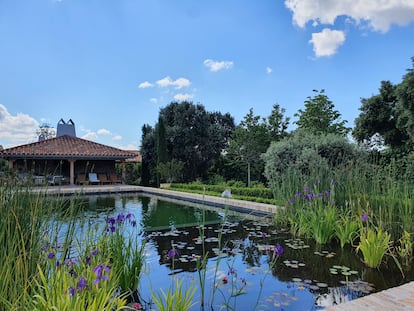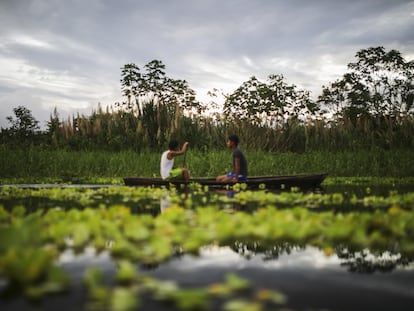What are biopools? Low-maintenance natural pools that are ecological and sustainable
These pools appear as lakes or ponds, surrounded by fauna… and the water doesn’t need chlorine, chemicals, or ultraviolet light to remain clean. Biopools may be the best environment for a dip

Biophilia – the instinctive impulse that encourages humans to seek connection with nature as a means of feeling good – is a kind of natural medicine that is here to stay, following the lockdowns during the worst of the pandemic.
Deep sensory interaction – with plants, animals, minerals and any other manifestation of the natural world – is a proven therapeutic method. It can be achieved in both simple and sophisticated ways, be it by going to a picnic, renting a country house, strolling through a park, growing plants on the balcony, or simply watching the sunset. Who hasn’t heard of the benefits that come from hugging trees, smelling flowers, or meditating while listening to hundreds of sounds that are hidden in the forest?
In the middle of the summer heat, yearning for less takes the shape of biopools: swimming pools that are camouflaged as lakes or ponds. In Spain, natural pools abound in some rivers, while countries such as Germany are pioneers in this practice. A good example is the Heigenbrücken natural pool, which has been operational since 1928. Old conventional swimming pools are also being naturalized, to convert them into spaces for biodiversity and recreation in which – around the pure water – dynamic aquatic ecosystems are unleashed.
In recent years, thanks to the boom in the landscaping of leisure spaces, many hotels have built impressive natural pools, also known as biopools. To name just a few, there’s the Mas Ardèvol agrotourism, on the Costa Daurada (Catalonia, Spain); La Jument Verte farm, in the town of Aix-Les-Bains (France); the Naturhotel Edelweiss Wagrain, in Austria; or the rural Hotel Scarlet, in Cornwall (England).
“The sensation of bathing in a natural pool is very different from doing it in a conventional one,” say the landscape designers María Barceló and Xoan Pérez, from Estudio MIX Paisajismo. “The palette of deep greens loaded with nuances in the background, the touch and aroma of the surrounding vegetation, the sound of fluttering birds and insects all convey the sensation of being in a small, natural lake.”
A balanced space
The key to natural pools is ecological balance. Schematically, they consist of a bathing vessel, next to which there is a regeneration area. It’s essential for the water to remain purified without the need for chlorine, chemicals, ultraviolet light or ultrasound. There should be no need to control the pH balance of the water in an artificial way. The water must remain in motion, circulating between the bathing area and the regeneration area. It can be driven towards the latter by means of a pump or by inertia. As in natural wetlands, colonies of bacteria spontaneously arise in this pure water, allowing it to remain clean in a self-sufficient way.
The regeneration space must include a physical filtering area – composed of sand and gravel particles of different sizes, which retain leaves, dust, hair and any floating elements – and the plants themselves, which function as a biological filter. The vegetation purifies the water, thanks to the fact that it absorbs nitrates and provides oxygen through the roots in the substrate, preventing the liquid from being corrupted. The water is alive: it harbors a legion of beneficial bacteria and microorganisms that break down the dirt that would end up spoiling it.
There are many suitable species – both submerged and marginal – that can be planted in a natural pool. “In Spain, the most common are lilies (Iris pseudacorus and Iris sibirica), rushes (Scirpus holoschoenus), cattails (Typha laxmannii) and certain buttercups,” explains Enric Sancho, director of Cultidelta – a nursery specializing in native plants. “But in the plant world, you can never generalize. The viability of the species will depend on the geographical location and the quality of the water,” Sancho warns. “You have to be very careful not to choose invasive species. For example, certain species of cattails and reeds – such as Typha latifolia, Typha angustifolia or Phragmites australis – have very vigorous rhizomes that could occupy the entire space and generate a monoculture, so I would rule them out.” He offers up possible alternatives: “it’s better to use bulrush with a contained habit – such as Typha laxmannii, Typha minima, Juncus inflexus – or colorful floral herbaceous plants, such as Iris pseudacorus.”
Plants and bugs… naturally
The amount of exposure that a biopool has to the sun determines the life that will be generated in the water. “The more heat and insolation, the greater the possibility of the appearance of algae. And, depending on the species chosen, [there could be] more mosquitoes,” Sancho explains. To deal with this, the frequent renewal of the water is necessary.
The planting scheme must be well studied, so that there are species with and without flowers, offering different textures, as well as various shades of green that complement each other and help the construction blend in with its surroundings. According to the designers at Estudio MIX, “the color that the water will project is another element to take into account… this can be modified depending on the internal material of the glass.” Another very expressive element is the inclusion of water jets. “Something that differentiates natural pools from traditional ones is the sound of the water. A jet can be installed that, in addition to helping with the oxygenation of the pool, attracts the attention of whoever approaches it.”
Being a living element, the natural pool is much more than a bathing facility: it’s an esthetic event that reflects the cycle of the seasons. During the summer, plants emerge from the water, creating an enveloping sensation of immersion in nature. “The end of autumn and winter – when the aquatic [plants] acquire decadent tones and capture the light in a dramatic way – contains the most poetic moments,” they say at Estudio MIX. “In spring, the volumes of the new shoots break the horizontality of the sheet of water, reflecting endless shades of fresh green. The garden fills with the sounds of birds; pollinators begin their scouting movement in search of the valuable first flowers of the season.” With luck, dragonflies, butterflies, frogs and minnows will end up settling around the biopool, attracted by a suitable habitat.
“Biopools are healthy: their pure, living water is gentle on the skin and pleasant to the touch,” says André Schäller of the German engineering company Janisch & Schulz. “The presence of animals indicates this purity. The purification of the water by means of gravel and vegetation makes it possible to dispense with chemicals and electric filters, protecting health and the environment,” he adds.
While they require a higher initial investment, in the medium term, natural pools require less maintenance than conventional ones. “Sustainability is a concept in which different interpretations fit, but what we can all agree on is that it’s necessary to use water responsibly,” affirm the designers at Estudio MIX. Thanks to the biopool’s natural regeneration cycle – which keeps the habitat alive – it’s not necessary to constantly empty and refill the pool. There’s only the need to replace the water that evaporates. The pump to circulate the water can be powered by solar energy. No chlorine or chemicals are needed to treat the water. This all implies energy savings.
Natural pools have pros and cons. Among the cons, we must take into account that the water in them won’t be completely transparent, as algae will appear. And, if the species of plants aren’t selected properly, so will mosquitoes. But, on the plus side, ecology and sustainability are favored, maintenance needs are reduced and the esthetic possibilities of plants can be enjoyed by bathers and loungers.
That long-awaited dip in the middle of increasingly hot summers in a pool enveloped by nature is pure therapy. There’s no need for selfies: just turn off your phone and dive in.
Sign up for our weekly newsletter to get more English-language news coverage from EL PAÍS USA Edition








































